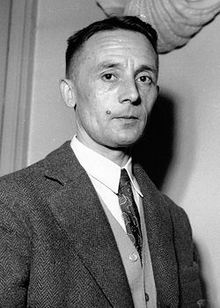You can helpexpand this article with text translated fromthe corresponding articlein French.(December 2017)Click [show] for important translation instructions.
|
This article includes a list ofgeneral references,butit lacks sufficient correspondinginline citations.(December 2017) |
Julien Gracq(French:[gʁak];27 July 1910 – 22 December 2007; bornLouis PoirierinSaint-Florent-le-Vieil,in the FrenchdépartementofMaine-et-Loire) was a French writer.[1]He wrote novels, critiques, a play, and poetry. His literary works were noted for their dreamlike abstraction, elegant style and refined vocabulary. He was close to thesurrealist movement,in particular its leaderAndré Breton.[1]
Julien Gracq | |
|---|---|
 Gracq in 1951 | |
| Born | Louis Poirier 27 July 1910 Saint-Florent-le-Vieil,Maine-et-Loire,France |
| Died | 22 December 2007(aged 97) Angers,France |
| Occupation | Novelist, critic, playwright, poet |
| Education | University of Paris |
| Period | 1938–2002 |
| Signature | |
 | |
Life
editGracq first studied in Paris at theLycée Henri IV,where he earned hisbaccalauréat.He then entered theÉcole Normale Supérieurein 1930, later studying at theÉcole libre des sciences politiques(Sciences Po.), both schools of theUniversity of Parisat the time.
In 1932, he readAndré Breton'sNadja,which deeply influenced him. His first novel,The Castle of Argol,is dedicated to that surrealist writer, to whom he devoted a whole book in 1948.
In 1936, he joined theFrench Communist Partybut quit the party in 1939 after theMolotov–Ribbentrop Pactwas signed.[2]
During the Second World War, he was a prisoner of war in Silesia with other officers of the French Army. One of the friendships he formed there was with author and literary critic Armand Hoog, who later described Gracq as a passionate individualist and ferociously anti-Vichy.[3]
In 1950, he published a fierce attack on contemporary literary culture and literary prizes in the reviewEmpédocletitledLa Littérature à l'estomac.When he won thePrix GoncourtforThe Opposing Shore(Le Rivage des Syrtes) the following year, he remained consistent with his criticism and refused the prize.[1]
Gracq taught history and geography in secondary school (high school) until he retired in 1970.
In 1979, he wrote the foreword to a re-edition of theJournal de l'analogiste(1954) bySuzanne Lilar,a work he called a "sumptuous initiation to poetry" ("une initiation somptueuse à la poésie").
In 1989, Gracq's work was published by theBibliothèque de la Pléiade.He remained distant from major literary events and faithful to his first publisher,José Corti.
Gracq lived a quiet life in his native town of Saint-Florent-le-Vieil, on the banks of the riverLoire.On 22 December 2007, a couple of days after suffering a dizzy spell, he died at the age of 97 in a hospital inAngers.
The Opposing Shore
editThe Opposing Shore(Le Rivage des Syrtes,1951) is Julien Gracq's most famous novel.
A novel of waiting, it is set in an old fortress close to a sea which defines the ancestral border between the stagnant principality of Orsenna and the territory of its archenemy, the mysterious Farghestan. Its lonely characters are caught in a no man's land, waiting for something to happen and wondering whether something should be done to bring about change, particularly when change may mean the death of civilisations.
Works
edit- Au château d'Argol,1938 (novel) (English translation:The Castle of Argol)
- Un beau ténébreux,1945 (novel) (English translation:A Dark Stranger)
- Liberté grande,1946 (poetry) (English translation:Great Liberty)
- Le Roi pêcheur,1948 (play)
- André Breton, quelques aspects de l'écrivain,1948 (critique)
- La Littérature à l'estomac,1949
- Le Rivage des Syrtes,1951 (novel) (English translation:The Opposing Shore)
- Prose pour l'Étrangère,1952
- Penthésilée,1954 (play; translation of Kleist'sPenthesilea)
- Un balcon en forêt,1958 (novel) (English translation:Balcony in the Forest)
- Préférences,1961
- Lettrines,1967
- La Presqu'île,1970
- Le Roi Cophetua,1970 (novel) (English translation:King Cophetua); it inspired the filmRendezvous at Bray,directed byAndré Delvaux
- Lettrines II,1974
- Les Eaux Étroites,1976 (Allusions, allegories and metaphors on a French river, l'Èvre.) (English title:The Narrow Waters)
- En lisant en écrivant,1980 (English translation:Reading Writing)
- La Forme d'une ville,1985 (English translation:The Shape of a City)
- Autour des sept collines,1988
- Carnets du grand chemin,1992
- Entretiens,2002
See also
edit- Le Monde's 100 Books of the Century,a list which includesThe Opposing Shore
References
edit- ^abc"Julien Gracq, 97, Iconoclastic French Surrealist Writer".The New York Times.24 December 2007.
- ^Bowd, Gavin (Summer 2004). "The Political Landscapes of Julien Gracq".Dalhousie French Studies.67:121–133.
- ^Bernhild Boie, « Chronologie », in Julien Gracq,Œuvres I,Paris, Gallimard, Bibliothèque de la Pléiade, p. LXI.
- Jean-Louis de Rambures,"Comment travaillent les écrivains", Paris 1978 (interview with J. Gracq)
- Encounters with Julien Gracq ",by Gérard Bertrand
- Dominique Perrin, "De Louis Poirier à Julien Gracq", Paris, Classiques Garnier, 2009, 759 p.